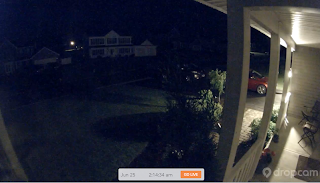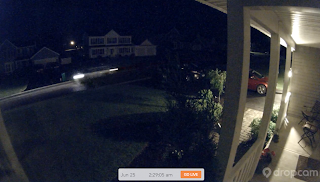
Can a Dropcam be setup outside? Officially: no. Unofficially: yes
Update 6/29/2015
Dropcam / Nest has recently released the Nest Cam. Does the Nest Cam work outdoors? Nope; it has very similar specs to the Pro, and so all the rest of this post is likely to remain applicable. I cannot tell if the dimensions are exactly the same, though they certainly look to be very similar if not unchanged.
--------
I still get regular hits to my review of the Dropcam HD I posted last year. I still like the camera--and I love the Dropcam Pro (released last fall) even more. However, both of these are indoors-only cameras. To this day Dropcam's most popular feature request thread is for an outdoor model. Dropcam has expressed little public interest in an outdoor model, and more or less ignores its own feature request thread, so for now we're collectively in the dark if we want official support for an outdoor model of Dropcam.The challenge with setting up a Dropcam camera outdoors
Dropcam clearly states their cameras are for indoor use only. Some of the technical reasons for this include- Operating temperature - Both the Dropcam HD & Pro are rated for temps between 0-35 C.
- Water resistance - Simply, there isn't any; if these get wet, they won't work.
- Wireless range - Wi-fi works best with line of site, and exterior walls in particular can degrade a signal, thus substantially limiting the effective range of the camrea.
- Inrared light range - The Dropcam's built in LEDs that emit infrared for night vision are too low in output for an exterior environment
How to setup a Dropcam to run outdoors
On paper these things aren't particularly suitable for outdoors. I have one of my cameras inside, flush against a bay window and, since the window is angled toward the house, it covers my patio nicely. If this isn't an option for you, and you're willing to void the warranty, you might be in luck with an alternate approach.The most obvious solution is to install the Dropcam under an overhang (porch, eave, etc.) The second most obvious solution is to build an enclsoure. Many people have tried various enclosures built from PVC, plexiglass, etc. A few small companies have even put out some products. The biggest thing you should probably forget about using is the camera's night vision mode. Even the $50 Dropcase appear to struggle with this. Others who have attempted their own enclosures have generally found it's very difficult to send the infrared signal through glass or plastic with it a) maintaining its strength and b) not reflecting off the material back into the camera lens.
In any case, as I mentioned earlier, the truth is the infrared signal is too weak to be of much value outdoors anyway, unless it's intended to cover only a small area, such as a porch. My advice is to turn off night vision mode entirely and illuminate the area with ambient lighting. This is only worthwhile with the Dropcam Pro, which has a fairly good image at night (the HD's night image is poor). Even then, the Pro is still only a $200 camera and although its low-light image is fairly good (this image taken in the middle of the night):

it struggles mightily in low-light conditions on moving objects (this car going no more than 25 mph--I can make out it's light colored, but not much else):

If you're dead-set on infrared you could get secondary infrared lights to bathe the area in question. You can then leave the camera's night-vision mode on (which means it will read infrared and also turn on its own lights), but if reflecting within your enclosure is a problem you'll need to tape over the LED lights on the Dropcam itself.
Any half-decent enclosure should be rain/snow resistant, but heat build up is a real problem. These cameras produce a lot of heat and an improperly built enclosure is going to trap it, thereby allowing the the Dropcam to get too hot. An enclosure with an open bottom and large area behind the camera can help to mitigate this. I think it could suffice to build a tiny enclosure that only covers the seams of the camera so that its shell is uncovered as much as possible. I suspect a quarter-sized piece of plastic glued over the lens' edges only, with a bead of silicon run around the seams and finally applied liberally around the connection point, would be very cheap, effective, and solve all of the problems that others have had with enclosures. Nonetheless, enclosure or not, it is preferable to keep the camera away from direct sun. Low temps, even those well below freezing, do not appear to be a problem.
Some enclosures people have built for their Dropcams:
- Dropcase
- Homemade case withstanding rain and ocean. I like what this guy did; instead of trying to solve the problem of enclosing the entire Dropcam, he realized (similar to my idea above) that most of the Dropcam is already in a water-proof enclosure; cover the seams, and it appears to hold up just fine. That said, his first "minimal" attempt died after six weeks!
- Another homemade case
- Homemade case Of the design the builder says "In my camera's almost 7 months of constant outdoor operation it has been through temperature ranging from 3F (-15F wind chill) to 95F and humidity of 80%+". Also says it works with the Dropcam Pro.
- Kickstarter project for a Dropcam shell. Not sure what happened to this; the pledge goal was not met, in any case.

No comments:
Post a Comment